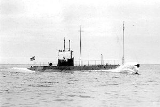
United States L class submarine
Encyclopedia
The United States L class submarine was the United States Navy
United States Navy
The United States Navy is the naval warfare service branch of the United States Armed Forces and one of the seven uniformed services of the United States. The U.S. Navy is the largest in the world; its battle fleet tonnage is greater than that of the next 13 largest navies combined. The U.S...
's first attempt at designing and building ocean-going submarines, which at the time was a yawning gap in capability compared with other major navies. The first hulls were laid down six months before the European hostilities, but they were not commissioned until two years later because of long fitting-out periods.
The Group 2 L-boats designed by Lake Torpedo Boat
Lake Torpedo Boat
The Lake Torpedo Boat Company of Bridgeport, Connecticut was an early maker of submarines for the U.S. Navy. Founded by Simon Lake in 1912, the firm competed with John Philip Holland's Electric Boat Company until financial difficulties led to the company's demise in 1924.-External links:**...
(L-5 through L-8) were built to slightly different specifications from the other Group 1 L-boats, which were designed by Electric Boat
Electric boat
While a significant majority of water vessels are powered by diesel engines, with sail power and gasoline engines also remaining popular, boats powered by electricity have been used for over 120 years. Electric boats were very popular from the 1880s until the 1920s, when the internal combustion...
, and are sometimes considered a separate L-5 class.
After service in the Atlantic Flotilla
Flotilla
A flotilla , or naval flotilla, is a formation of small warships that may be part of a larger fleet. A flotilla is usually composed of a homogeneous group of the same class of warship, such as frigates, destroyers, torpedo boats, submarines, gunboats, or minesweepers...
by the Group 1 boats, most required extensive refits at Philadelphia after the USA's entry into the First World War which reflected the US Navy's then limited experience in ocean operations.
In November 1917, the class was sent to the Bantry Bay
Bantry Bay
Bantry Bay is a bay located in County Cork, southwest Ireland. The bay runs approximately from northeast to southwest into the Atlantic Ocean. It is approximately 3-to-4 km wide at the head and wide at the entrance....
and the Azores
Azores
The Archipelago of the Azores is composed of nine volcanic islands situated in the middle of the North Atlantic Ocean, and is located about west from Lisbon and about east from the east coast of North America. The islands, and their economic exclusion zone, form the Autonomous Region of the...
for anti-U-boat
U-boat
U-boat is the anglicized version of the German word U-Boot , itself an abbreviation of Unterseeboot , and refers to military submarines operated by Germany, particularly in World War I and World War II...
patrols. The class did not sink any U-boats.
The class was generally under-powered, but they enjoyed good endurance for patrols in the North Atlantic and in British waters.
After the war, the L class were involved in trials of new torpedoes and hydrophone
Hydrophone
A hydrophone is a microphone designed to be used underwater for recording or listening to underwater sound. Most hydrophones are based on a piezoelectric transducer that generates electricity when subjected to a pressure change...
equipment on both the east and west coasts before decommissioning in 1922 and 1923 and were used in the US scrapping quota in 1933 under the London Naval Treaty
London Naval Treaty
The London Naval Treaty was an agreement between the United Kingdom, the Empire of Japan, France, Italy and the United States, signed on April 22, 1930, which regulated submarine warfare and limited naval shipbuilding. Ratifications were exchanged in London on October 27, 1930, and the treaty went...
limiting naval armament.

